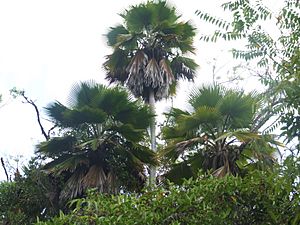Kilauea pritchardia facts for kids
Quick facts for kids Kilauea pritchardia |
|
|---|---|
 |
|
| Scientific classification | |
| Genus: |
Pritchardia
|
| Species: |
beccariana
|
The Pritchardia beccariana, also known as the Kilauea pritchardia or Beccari's loulu, is a type of palm tree. It grows only in the wet forests on the eastern side of the island of Hawaiʻi, close to Hilo. This makes it an endemic species, meaning it's found nowhere else in the world!
Contents
About the Kilauea Pritchardia Palm
This amazing palm tree can grow very tall, reaching up to about 20 meters (65 feet). Its trunk is smooth and grayish, usually about 20-25 centimeters (8-10 inches) wide.
Leaves and Flowers
The Pritchardia beccariana has large, round leaves that can be up to 1.8 meters (6 feet) wide and just as long. These leaves are held up by stalks called petioles, which are also about 1.8 meters (6 feet) long. The underside of the leaves can be a bit fuzzy.
Its flowers grow in clusters that are shorter than or the same length as the leaf stalks. These flower clusters are a bit fuzzy when they first bloom, but become smooth when the fruits start to grow.
Fruits and Habitat
After the flowers, the palm produces large, black, oval or round fruits. They are about 3.8 centimeters (1.5 inches) long and 3.2-3.8 centimeters (1.25-1.5 inches) wide when they are ripe.
This palm grows at elevations from about 300 to 1,280 meters (1,000 to 4,200 feet). It needs a lot of rain, more than 250 centimeters (100 inches) per year. In the past, it grew closer to sea level. However, as towns and farms grew, much of its original forest home was lost.
Threats to the Palm
Today, the Kilauea pritchardia faces several challenges. Its natural habitat is shrinking, and new plants (weeds) are invading its space. Also, animals like rats and pigs sometimes eat the young palm seedlings, stopping new trees from growing.
Discovery and Naming History
The Pritchardia beccariana was discovered in December 1914 by a scientist named Joseph Rock. He found it near Kīlauea at an elevation of about 1,067 meters (3,500 feet).
Honoring a Friend
Rock officially named and described the palm in 1916. He named it to honor his friend and fellow scientist, Odoardo Beccari. Rock told Beccari that this palm was "a beautiful palm of fine symmetry" and very different from other Pritchardia palms he knew. He thought its leaves looked most like the Fiji fan palm.
The Giffardiana Variety
Later, Rock collected more palm samples from a higher elevation, about 1,280 meters (4,200 feet), near Kīlauea. These samples were smaller than the Pritchardia beccariana he first found. Rock thought it might be a new species.
However, Beccari believed the differences were due to the higher elevation where they grew. He decided it wasn't a new species, but he did create a special variety called giffardiana. This was to honor Walter M. Giffard, who helped collect the specimens.
How People Use This Palm
Native Hawaiians traditionally valued the fruits of Pritchardia palms as a food source.
Traditional Uses
The young, unripe fruits were called hāwane or wāhane. People would gather them and eat the soft inside part, which tasted a bit like coconut meat.
The large leaves were also very useful. They were collected to make thatch for roofs, as well as for weaving fans, umbrellas, hats, and baskets. Even the strong trunks were used to make spears and for building materials.
Growing the Palm Today
The Pritchardia beccariana is also grown as a landscape palm in tropical and subtropical areas. People who collect palms, especially in places like southern California, Southern Europe, and southern Australia, really like Hawaiian Pritchardia palms. This is because they can handle cooler temperatures better than some other types of Pritchardia from the South Pacific.
This palm looks a lot like the beautiful Fiji fan palm and another South Pacific species, Thurston's fan palm.
Gallery





